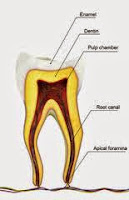When it comes to dental care, many people are very
self-conscious when it comes to their smiles. While we also understand the
gravity and importance of good dental care and habits, most of us cringe at the
thought of having to go to the dentist. One of the things that scare most
people about the dentist is the horror stories that we hear about it. If we
take the time to understand the procedures that the dentist may need to do, it
may take some of the enigma out of going to the dentist. One of the most common
confusions among dental procedures is the difference between a crown and a root
canal.
Root Canal Treatment
A root canal can be painful however, if you need a root
canal, chances are you have already been in a considerable amount of pain.
Going through this procedure is going to alleviate the pain that you have been
experiencing. A root canal is performed when a cavity has reached extensive
levels. Extensive levels means that the decay has reached the pulp. The pulp is
the area of the tooth where the nerves are located. In some cases, the nerve
may even be exposed, which is extremely painful. This type of infection cannot
be simply filled because it would not stop the infection from spreading.
Other reasons that a root canal may be performed are in the
case of serious oral trauma. The root canal process itself is one that
desensitizes the tooth. The nerves and pulp are removed. This is usually done
over a couple of visits, up to four, but can also be performed in one session.
This would depend on the particular situation. After the root canal is
completed, the tooth will be brittle. At this point a post and crown will be
needed.
The Crown
A crown is placed on the tooth to protect the tooth after a
root canal procedure. It can also be placed on the tooth if there is an
extensive cavity that has not yet reached the pulp. In this case, the tooth
will be ground down and an impression will be made of the remaining tooth. A
temporary crown will be placed on the tooth to protect it from further
infection or damage until the permanent crown is completed. Depending on the
dentist, it can be just a few days to several weeks before the permanent crown
is complete. The temporary will then be removed and the permanent crown will be
affixed to the modified tooth. Again, a crowned tooth does not always require a
root canal. In the case of a tooth that has not been root canaled, a post will
not need to be installed. The primary function of the post is to strengthen the
tooth before crowning.
Although the difference between a crown and root canal are
obvious, these two procedures can be very closely related. If you have
questions regarding the treatment that your dentist is recommending, ask them.
They will be more than happy to explain.
Beat Tooth And Gum Disease Now - Keep Healthy Teeth For Life While Saving Dental Dollars! With Over 200 Pages, This Is No Skimpy Report, Rather, Must-have Information For You And Your Family - Quick And Easy Changes To Your Routine You Can Make Right Now! Learn More By Clicking Here!

No comments:
Post a Comment